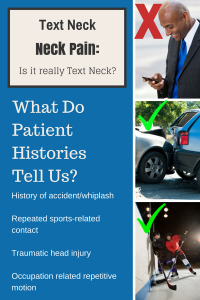Ask the Docs

4 Reasons Why Text-Neck is Not a Thing:
Why Blaming Your Phone for Your Neck Pain is Plain Wrong
Last week, the main stream media went crazy with articles talking about the danger of a new phenomenon called ‘Text-Neck.’ See my related video on this subject.
Now this is actually something that chiropractors have been discussing for the past 7 or 8 years when text messaging really took off as a primary form of communication. In the past, I’ve even fallen to the trap of telling patients that their text messaging posture could cause their neck to go out.
After several years of practice under my belt, and taking a look at biomechanical research, I have to say that blaming the condition of your neck on text messaging just seems down right silly.
Why is it wrong?
In 2014, it’s hard to imagine life without text messaging. It’s the most common method of communication, out pacing email and phone calls by a tremendous margin. Doctors use it to confirm appointments, websites use it to send secure communication, and dating is a near impossibility without it. The booming popularity of Smart Phones, has also provided an additional avenue for people to stay glued to their phones in a forward flexed position for hours at a time.
While the idea of Text-neck may sound pretty from a theoretical model of biomechanics, it just doesn’t really add up clinically.
- Where is the spike in neck problems? – If text-neck is the problem it is made out to be, why isn’t there a spike in neck related problems happening in our younger generation? The world of medical research is very keen on identifying unusual spikes in reasons people go to doctors, especially if these spikes happen in young people. Thus far, there’s been nothing published about rising prevalence in neck dysfunction.
- Programs to change work place posture have failed, why would changing your phone posture work? – Attempts have been made to develop programs that change work place posture ergonomics to see if they have an impact on prevention or recovery from neck pain and back pain. The end result? They were the same as people that did nothing.Additionally, I’ve worked with lots of chiropractors and PT’s in the past who have made ergonomic recommendations to address this problem. In my previous history, I have never seen anyone’s neck get better because they’ve changed their cell phone habits. Not on x-ray improvement, and not on symptom improvement.
- Health History of People with Neck Problems –Here’s my favorite one. People LOVE, LOVE, LOVE to blame their neck problems on their work and computer time, and they will always minimize the effect of a car accident or fall.It’s actually kind of funny. People will literally say that a multi-car accident with roll overs, and immense car damage couldn’t possibly be the problem, because they didn’t feel pain immediately after the incident.But if they work on a computer all day for their job, then that is the first thing that they bring up.People with primary neck pain (not caused by inflammatory arthritis, Fibromyalgia, other chronic pain syndromes) typically have a past history of head/neck trauma, occupationally related repetitive movement (dentists), or sports related sprain/strain.
- Probably my favorite, but exclusively theoretical reasoning why Text-neck is silly. It actually deserves it’s own subheading….
Is the Human Body That Weak?
For thousands for years, the human body has endured and adapted through some pretty remarkable circumstances. In Africa and Asia, women routinely carry dozens of lbs of rice, fruit, and water on their head for miles so that they can feed their families or run a business. In fact, there are brick carriers in Bangledesh that are known for their ability to carry 100 bricks on their head, and that’s what they do for money!
 Humans have evolved and survived because of their ability to survive and push their bodies to do these remarkable feats. Whether it’s drinking contaminated water, lifting insane weight over their heads, running hundreds of miles,or fighting animals that are bigger and stronger that us.
Humans have evolved and survived because of their ability to survive and push their bodies to do these remarkable feats. Whether it’s drinking contaminated water, lifting insane weight over their heads, running hundreds of miles,or fighting animals that are bigger and stronger that us.
We’ve build pyramids, survived unthinkable cold and heat, and routinely walk away from car accidents that should kill us.
In my honest opinion, I feel that this rise of text-shaming is just an easy scape goat for people to excuse the fact that neck pain is not resolving, even under therapy.
So is your texting posture not important?
If you look at some of my previous posts, you’ll see some of my views on posture. For reference, you can look specifically at this article:
Why Your Posture Isn’t That Important
What’s more important is that your body has CONTROL over your posture, aka Postural Control which falls under a bigger umbrella of neuromuscular control.
What does that mean? It means that when you want your body to be straight and upright, that your body is capable of being straight and upright. It means that when you are choosing to lift a heavy weight over your head with good form, that your body is capable of performing that task without any breakdown.
Why? Because neuromuscular control is a strong indicator of overall brain health, and good brain health means you can resist pain and dysfunction better.
While ergonomics may play a role in controlling pain and dysfunction that is already there, evidence is showing that it does nothing to prevent or recover from injuries to the neck. If we really want to get to the bottom of neck function, you have to address what began the cascade of dysfunction, and that is usually a previous history of force or trauma applied to the spine.
Trauma –> Structural Shifting –> Distorted input and perfusion to the brain –> Changes in Brain function –> Poor Neuromuscular Control
So we can either fiddle around with the position of our phone, and honestly get no where, or we can focus on
1. Identifying the cause of someone’s dysfunction (disc, structure, mechanics, sensitivity)
2. Address problems in the brain and nervous system
3. Provide new movement patterns to increase functionality
***
Did you like this article? Feel free to share it with the people you care about and see if a Complimentary Consultation is the next step to regain their health.
Dr. Chung is a practicing Structural Chiropractor in the West Palm Beach area. He has been published in peer reviewed scientific journals and is a sought after speaker in health and wellness. Follow his blog at http://chiropractorwellington.com/category/keystone-chiropractic-blog/ or find him on twitter at @drjonathanchung



